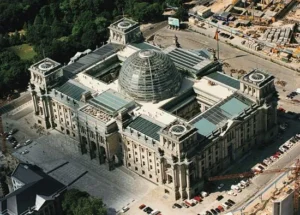Description
The Reichstag Building in Berlin, Germany, is a landmark of historic and political significance, serving as the home of the Bundestag, Germany’s federal parliament. Originally completed in 1894, it was designed by architect Paul Wallot in a neo-Renaissance style. The building’s imposing façade and grand interior reflect its role as a symbol of German democracy. Throughout its history, the Reichstag has been central to many pivotal events, including the infamous Reichstag fire of 1933, which was a catalyst for the rise of the Nazi regime, and the subsequent damage it sustained during World War II.
Following the war, the Reichstag fell into disrepair and was largely abandoned until it was restored in the early 1990s after the fall of the Berlin Wall. The renovation was spearheaded by British architect Norman Foster, who added a striking modern glass dome to the building. This dome, completed in 1999, is both a functional and symbolic element, allowing natural light to penetrate the parliamentary chambers below while offering visitors panoramic views of Berlin. The dome's design emphasizes transparency and openness, reflecting Germany's commitment to democratic values.
Tourists should visit the Reichstag Building to explore its rich historical and architectural heritage. The building’s combination of historic grandeur and modern design offers a unique perspective on Germany's past and present. Visitors can enjoy guided tours, explore the iconic glass dome, and gain insights into the workings of Germany’s democratic institutions. The Reichstag’s role as a symbol of political resilience and democratic transparency makes it a compelling and educational destination for anyone interested in history, architecture, and contemporary politics.
Location
-
Platz der Republik 1, Berlin, Germany






